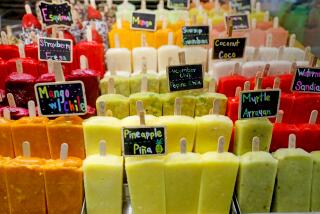FOOD : A Spanish Disposition : Forget the Myth That Seafood Is a Must Ingredient in an Authentic Paella
- Share via
‘IF YOU ADD snails to your paella,” an elderly, sun-wizened paellero or master paella - maker told me one afternoon a few years back in Benisano, near Valencia on the east coast of Spain, “you must never add rosemary.” But what were snails doing in a paella in the first place, I wondered, and why on earth should snails and rosemary be mutually exclusive? I soon learned the answer to both questions--and a good deal more about paella, too.
At the time, I had just begun my research into the subject and had what I suppose must be the typical American idea of paella: that it was basically an arrangement of rice and seafood, sometimes with chicken and/or sausage added, garnished with pimiento strips and green peas--and that it was more or less the national dish of Spain. That turned out to be quite far from the truth. What I discovered instead were these surprising facts (among others):
* Though it is served in all parts of Spain today (and throughout the rest of the world, too, for that matter) in one form or another, paella is an invention of the Valencia region. Locals go so far as to claim, in fact, that the dish can be properly interpreted only in that area, because only there does the water have the particular mineral content to make paella taste as it should.
* Paella must be made with short-grain rice, similar to the Italian arborio rice essential to risotto--and not at all with the long-grain variety many recipes call for.
* Unlike risotto, which must be stirred constantly while cooking, paella shouldn’t be stirred at all once its ingredients have been combined.
* To ensure proper cooking, paella must be made only in a wide, flat paella pan (called a paella itself in most of Spain--though, confusingly, Valencians call it a caldero ) .
* The brown crust that forms on the bottom of the paella pan as a result of the rice not being stirred is highly prized by most aficionados of the dish. (It’s called the socarat in the Valencian dialect of Catalan.)
* Paella should be served not hot but at room temperature (to let the flavors marry, Valencians say) and should be eaten only at lunchtime, since a well-made paella is considered too heavy to eat before going to bed.
* Perhaps the most surprising fact of all about paella is that it doesn’t have to include seafood. The original paella valenciana was an inland dish, traditionally made with chicken, rabbit, snails, white beans, yellow lima beans and string beans, with a bit of onion and tomato added. Seafood was a later refinement.
Oh, and about the rosemary: It is an herb that flavors paella nicely--but snails in the Valencian countryside that eat rosemary as part of their daily diet are already flavored with it themselves. Adding more rosemary to a paella that already contained snails would be rosemary overkill.
One delicious and unusual variation on paella, served every Wednesday at the El Plat restaurant in Valencia, uses no animals or sea creatures at all--just vegetables and rice. Here is my version of that dish.
PAELLA WITH VEGETABLES (Paella amb Verdures)
Olive oil
2 onions, chopped
4 tomatoes, peeled, seeded and finely chopped
3 leeks, white parts only, chopped
6 medium artichoke hearts, halved and sprinkled with lemon juice
3 sweet red (preferred) or green peppers, roasted, peeled and cut into thin strips
1/2 head cauliflower, broken into florets
1/2 cup fresh or frozen peas
5 1/2 cups chicken or vegetable stock
4 cloves garlic, minced
2 sprigs parsley, minced
Salt
1 pound short-grain rice
Prepare basic sofregit in a paella, cassola or other wide, flat-bottomed pan by covering bottom of pan with at least 1/2-inch oil. Heat for several minutes. Then add onions, reduce heat, and cook, uncovered, until onions are tender, stirring occasionally. Continue cooking until onions have turned golden-brown and are beginning to caramelize, adding and cooking off small amount of water, if desired.
Add tomatoes and leeks and mix well. Continue cooking until all liquid has evaporated and tomatoes and leeks have begun to “melt” into onions.
Stir in artichoke hearts and pepper strips, reserving 10 to 12 pepper strips for garnish. Stir in cauliflower and peas and add 1 cup stock.
Bring mixture to boil. Then simmer 10 minutes. Stir in garlic and parsley. Then add remaining 4 1/2 cups stock. Season to taste with salt. Stir in rice. Cook over medium high heat, without stirring, 20 to 25 minutes or until rice is done and liquid has evaporated. (If mixture seems to be drying out too quickly, reduce heat. If still soupy when cooking is almost finished, increase heat slightly. Do not stir once rice has been added.
Arrange reserved red-pepper strips on top of rice about 5 minutes before cooking is completed. When paella is finished, let stand 5 to 10 minutes off heat before serving. Makes 4 to 6 main-course servings, 6 to 8 appetizer servings or 8 to 10 side-course servings.
Note : Do not try to make paella on electric burner, which will create hot spot in middle of pan and burn rice.
The paella recipe is taken from “Catalan Cuisine” (Atheneum: $24.95) by Andrews, a regular restaurant columnist for The Times.
Food styled by Norman Stewart; prop styling by RoseMary Aguayo; plate courtesy of Cottura; glassware from Umbrello; forks from Tesoro Collection, Ltd.
More to Read
Eat your way across L.A.
Get our weekly Tasting Notes newsletter for reviews, news and more.
You may occasionally receive promotional content from the Los Angeles Times.









